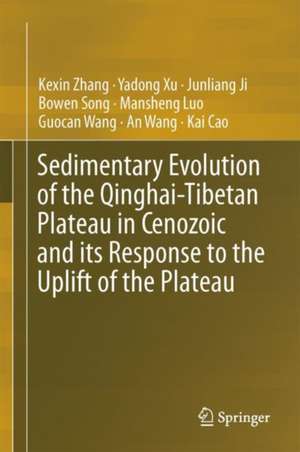Sedimentary Evolution of the Qinghai-Tibetan Plateau in Cenozoic and its Response to the Uplift of the Plateau
Autor Kexin Zhang, Yadong Xu, Junliang Ji, Bowen Song, Mansheng Luo, Guocan Wang, An Wang, Kai Caoen Limba Engleză Hardback – 13 iun 2025
Preț: 443.07 lei
Preț vechi: 602.44 lei
-26% Nou
Puncte Express: 665
Preț estimativ în valută:
84.78€ • 88.76$ • 70.15£
84.78€ • 88.76$ • 70.15£
Carte nepublicată încă
Doresc să fiu notificat când acest titlu va fi disponibil:
Se trimite...
Preluare comenzi: 021 569.72.76
Specificații
ISBN-13: 9789811065644
ISBN-10: 9811065640
Pagini: 150
Ilustrații: XII, 138 p. 45 illus., 20 illus. in color.
Dimensiuni: 155 x 235 mm
Ediția:1st ed. 2024
Editura: Springer Nature Singapore
Colecția Springer
Locul publicării:Singapore, Singapore
ISBN-10: 9811065640
Pagini: 150
Ilustrații: XII, 138 p. 45 illus., 20 illus. in color.
Dimensiuni: 155 x 235 mm
Ediția:1st ed. 2024
Editura: Springer Nature Singapore
Colecția Springer
Locul publicării:Singapore, Singapore
Cuprins
Introduction.- Tectonic-stratigraphic realm division and basin classification.- Petrological and chronostratigraphic framework.- Paleocene tectonic lithofacies paleogeography of the Tibetan Plateau.- Eocene tectonic lithofacies paleogeography of the Tibetan Plateau.- Oligocene tectonic lithofacies paleogeography of the Tibetan Plateau.- Miocene tectonic lithofacies paleogeography of the Tibetan Plateau.- Pliocene tectonic lithofacies paleogeography of the Tibetan Plateau.- Evolution of Cenozoic tectonic lithofacies paleogeography of the Qinghai-Tibetan Plateau and its response to the uplift of the Plateau.
Notă biografică
Kexin Zhang is the Associate Dean and the Chief Engineer at the Institute of Geological Survey, China University of Geosciences, Wuhan, China. He is also the chairman of the Palaeontological Society of Hubei Province and one of the council members of the All-China Commission of Stratigraphy. He was a member of the editorial board of the Journal of “Geological Science and Technology Information” and “Geological Bulletin of China”. Kexin Zhang obtained his BS in Paleontology and Stratigraphy from the Peking University, Beijing, China in 1982 and MS in Paleontology and Stratigraphy from the Beijing Institute of Geology, China in 1985. He received his Ph.D in Paleontology and Stratigraphy from the China University of Geosciences, Wuhan, China in 2000. He has published more than 280 academic papers and 19 books. His research interests involve micropaleontology, biostratigraphy, sequence stratigraphy, regional geological mapping research technology and methods, evolution of orogenic belt andCenozoic sedimentary and uplift of the Qinghai-Tibet Plateau. Prof. Zhang received a National Natural Science Second-Rank in 2002 (Research on Global Permian-Triassic Boundary Stratotype Section and Point) and a National Science and Technology Progress Special Award in 2011 (Theoretical Innovation and Breakthrough in Prospecting of Qinghai-Tibet Plateau), for his achievements in geological research.
Prof. Zhang has been the chairman of the project on sedimentary evolution of the Qinghai-Tibetan Plateau in Cenozoic since 2006 and has been responsible for the scientific research for the project.
Textul de pe ultima copertă
Based on highly detailed field investigations and test data from research on 98 different remnant basins, tectonic settings and lithostratigraphic sequences, this book describes the 4-stage evolution of the tectonic lithofacies paleogeography of the Qinghai-Tibetan Plateau, including Paleocene-Eocene, Oligocene, Miocene and Pliocene. It also discusses the contact relationship between the strata, the tectonic-lithofacies paleogeography evolution in the Cenozoic and their response to the tectonic uplift of the plateau. The continuous uplift and intensive intra-continental deformation during each turning point in the plateau divided the originally large sedimentary basins into numerous smaller ones filled with shrank of lacustrine-facies deposition and increased boulderstone accumulation, which indicates a response to the overall uplift of the plateau. Five major uplift events, which happened in 58-53 Ma, 45-30 Ma, 25-20 Ma, 13-7 Ma and since 5 Ma, respectively were identified. The paleogeographic configurations of the Tibetan Plateau turned over during the late Miocene, with high contours in the east during the pre-Miocene switching to the west after the Late Miocene
Caracteristici
Includes systematic, comprehensive national and international research on the Cenozoic strata of the Qinghai-Tibetan Plateau Divides Cenozoic strata of the Plateau into 5 stratigraphic realms and 13 stratigraphic subrealms Presents 5 stages and 11 substages of sedimentary events and their plateau-uplift response
